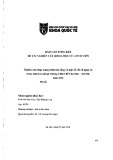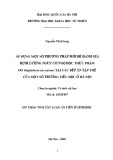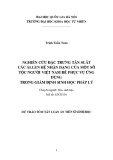
RESEARC H Open Access
Patient- and provider-related determinants of
generic and specific health-related quality of life
of patients with chronic systolic heart failure in
primary care: a cross-sectional study
Frank Peters-Klimm
1*
, Cornelia U Kunz
2
, Gunter Laux
1
, Joachim Szecsenyi
1
, Thomas Müller-Tasch
3
Abstract
Background: Identifying the determinants of health-related quality of life (HRQOL) in patients with systolic heart
failure (CHF) is rare in primary care; studies often lack a defined sample, a comprehensive set of variables and clear
HRQOL outcomes. Our aim was to explore the impact of such a set of variables on generic and disease-specific
HRQOL.
Methods: In a cross-sectional study, we evaluated data from 318 eligible patients. HRQOL measures used were the
SF-36 (Physical/Mental Component Summary, PCS/MCS) and four domains of the KCCQ (Functional status, Quality
of life, Self efficacy, Social limitation). Potential determinants (instruments) included socio-demographical variables
(age, sex, socio-economic status: SES), clinical (e.g. NYHA class, LVEF, NT-proBNP levels, multimorbidity (CIRS-G)),
depression (PHQ-9), behavioural (EHFScBs and prescribing) and provider (e.g. list size of and number. of GPs in
practice) variables. We performed linear (mixed) regression modelling accounting for clustering.
Results: Patients were predominantly male (71.4%), had a mean age of 69.0 (SD: 10.4) years, 12.9% had major
depression, according to PHQ-9. Across the final regression models, eleven determinants explained 27% to 55% of
variance (frequency across models, lowest/highest b): Depression (6×, -0.3/-0.7); age (4×, -0.1/-0.2); multimorbidity
(4×, 0.1); list size (2×, -0.2); SES (2×, 0.1/0.2); and each of the following once: no. of GPs per practice, NYHA class,
COPD, history of CABG surgery, aldosterone antagonist medication and Self-care (0.1/-0.2/-0.2/0.1/-0.1/-0.2).
Conclusions: HRQOL was determined by a variety of established individual variables. Additionally the presence of
multimorbidity burden, behavioural (self-care) and provider determinants may influence clinicians in tailoring care
to individual patients and highlight future research priorities.
Background
Chronic systolic heart failure (CHF) is a common clini-
cal syndrome, with increasing incidence at older age,
and is associated with high mortality rates, and compro-
mised health-related quality of life (HRQOL) [1]. More-
over, it is characterised by a high health care utilisation
constituting a high burden of disease, mainly due to
hospital admissions [1].
The objectives of CHF treatment are to maximise life
expectancy, improve HRQOL and prevent disease pro-
gression and admissions [2]. Optimal treatment accord-
ing to clinical practice guidelines [2] and adherence of
patients to treatment regimens [3] are paramount.
Given the likelihood of poor prognosis, maximising
HRQOL is particularly important, especially as a sub-
stantial number of patients with CHF prioritize HRQOL
over survival [4,5] and patients’perceptions of HRQOL
are used increasingly to evaluate the effectiveness of
healthcare interventions. Moreover, poorer HRQOL has
been shown to be predictive of higher admissions and
mortality [6,7].
* Correspondence: frank.peters@med.uni-heidelberg.de
1
Department of General Practice and Health Services Research, University
Hospital Heidelberg, Heidelberg, Germany
Full list of author information is available at the end of the article
Peters-Klimm et al.Health and Quality of Life Outcomes 2010, 8:98
http://www.hqlo.com/content/8/1/98
© 2010 Peters-Klimm et al; licensee BioMed Central Ltd. This is an Open Access article distributed under the terms of the Creative
Commons Attribution License (http://creativecommons.org/licenses/by/2.0), which permits unrestricted use, distribution, and
reproduction in any medium, provided the original work is properly cited.

HRQOL is a multidimensional concept comprised of
several domains, including physical/biological factors,
symptom status, functional status, health perceptions,
and overall well-being [8]. In research, the use of generic
and disease-specific instruments to assess HRQOL is
recommended [9,10].
Many previous studies have deepened the understand-
ing about what factors can determine HRQOL in CHF,
not least to identify intervention targets for improved
outcome. They have been performed in various sectors
and settings, mostly in secondary care or post-discharge
setting [11-22], some in primary care [23-25] and few in
the community [26]. Variance of HRQOL has been asso-
ciated with sociodemographic (e.g. age, gender, socio-
economic status [16,18,19,23,25,26]), psychosocial (e.g.
depression, anxiety, social support [12,18-21,23-25]),
behavioural (e.g. alcohol consumption and smoking
[11,25]), clinical (e.g. diseaseseverityassessedbyNYHA
functional class or peakVO
2
, multimorbidity, BNP
[11,13-17,20-25]) and procedural (e.g. vasodilator use
[11]) determinants. Heterogeneity of results may be
explained by different settings and study designs (e.g.
part of a clinical trial or observational study [20,21,25] vs.
survey [16,23,24]) leading to heterogeneous samples (e.g.
younger patients with systolic HF vs. elderly with HF
with preserved systolic function), by different ‘availability
of variables’and ‘use of instruments’for generic vs. dis-
ease-specific HRQOL assessment.
Given there is little evidence for patients with CHF
recruited in primary care, our aim was to identify and
explore the impact of determinants of generic and disease-
specific HRQOL with respect to a wide set of individual
and provider variables. We focused on an exploratory
comparison between generic and disease-specific HRQOL.
Methods
Design
This study was conducted as a cross-sectional study of
pooled baseline data of subproject 10 “quality of life”
within the German “Competence Network Heart Fail-
ure”, sponsored by the Federal Ministry of Education and
Research [27]. Within this subproject two primary care-
based trials (TTT and HICMan) evaluated different kinds
of interventions [28-30]. Both trials conformed to the
principles outlined in the Declaration of Helsinki [31]
and were approved by the institutional review boards of
the local medical faculty of the university and the Medi-
cal Association of the federal state Baden-Württemberg
in Germany, and were registered (ISRCTN08601529 and
30822978) prior to inclusion of patients.
GP and patient selection
Interested GPs were eligible for participation if they
were certified as a primary care physician or equivalent
and practiced as a statutory health insurance affiliated
physician. Fifty general practitioners(GPs)from48
practices participated in the two studies in one region of
Northern Baden, Germany.
Eligible patients were adults ≥40 years with confirmed
systolic heart failure (CHF) with stable symptoms at the
time of inclusion, and diagnosis of a chronic, irreversible
CHF at least 2 weeks prior to inclusion. CHF diagnosis
was based on dyspnea (NYHA) and objective measure-
ment (e.g. by echocardiography) of impaired left ventri-
cular systolic dysfunction (left ventricular ejection
fraction ≤45%). Criteria slightly differed between the
TTT-trial and HICMan-trial regarding the cut-off and
actuality of the determination of left ventricular ejection
fraction (TTT: ≤40% within last 6 months; HICMan:
≤45%, within the last 24 months) and dyspnea (TTT:
NYHA II-IV; HICMan: NYHA II-IV or NYHA I, if hos-
pital admission because of CHF within the last
24 months). Exclusion criteria were: Primary valvular
heart diseases and relevant hemodynamic effects, hyper-
trophic obstructive/restrictive cardiomyopathy (HOCM/
RCM), and people with a concomitant terminal illness,
addictive disorders (drug abuse or persisting alcohol
abuse despite social, legal or occupational conflicts),
dementia or severe psychological illness [28,30].
All GPs and patients gave written informed consent.
367 eligible patients were recruited, 168 within TTT
(enrolment of patients and data collection: March to
September 2005) and 199 within HICMan (enrolment of
patients and data collection: June 2006 to January 2007),
details have been described elsewhere [29,30]. Within
the HICMan-trial, two patients did not show up after
informed consent and 47 patients have participated in
the previous TTT-Trial. To obtain baseline data from
eligible patients “naive”of (the later tested) interven-
tions, we pooled baseline data of 318 patients (168+150).
Collection and management of Organisational and
Clinical data
GPs received an initiation visit by a study nurse includ-
ing an introduction to the trial’s investigator file. GPs
collected and documented organisational (location of
practice, list size, no. of GPs per practice, etc.), physi-
cians’individual (e.g. years in practice) and patients’
individual clinical data (e.g. history, current clinical
status, lab results, ECG, detailed medication etc.) on
pre-specified case report forms (CRFs) according to the
Basic Clinical Dataset (BCD) of the Competence Net-
work Heart Failure [27]. The documentation of patients’
history included single co-occurring medical conditions
(such as Angina pectoris, Peripheral Arterial or Cerebro-
vascular Disease, Hypertension, Diabetes, COPD,
Depression etc.. For chronic care in primary care in gen-
eral, as for patients with CHF [32], the co-existence of
Peters-Klimm et al.Health and Quality of Life Outcomes 2010, 8:98
http://www.hqlo.com/content/8/1/98
Page 2 of 11

multiple diseases is the rule rather than the exception
and therefore of special interest. Likewise, there is
co-existence of attempts to define the phenomenon of
co- and multimorbidity [33-37]: In one classification it
has been classified in three cumulative categories: simple
co-/multimorbidity (the co-occurrence of diseases,
whether coincidental or not); associative co-/multimor-
bidity (statistical association, not or not known to be
causal); and causal co-/multimorbidity (implying a cau-
sal relation among co-occurring diseases). Expanded
conceptualisations pay attention to „morbidity burden”
and „patient complexity”[38]: The former is linked to
its impact to patient-centred outcomes such as function-
ing and is therefore linked to the frailty construct. The
latter acknowledges socio-economic, cultural, beha-
vioural and environmental characteristics (see next para-
graph). These constructs address different aspects of
multimorbidity and are applied in three research areas
(clinical care, epidemiology and public health, and
health services research [38]. Accordingly, to retrieve an
estimate of patients’“morbidity burden”in addition to
the documentation of single co-occurring medical con-
ditions, GPs applied the Cumulative Illness Rating Scale
(CIRS-G) [39-41]: This index measures the chronic
medical illness ("morbidity”) burden while taking into
consideration the severity of chronic diseases in 14
items representing individual body systems. The final
score of the CIRS is the sum of each of the 14 scores,
theoretically varying from 0 to 56, a higher score indi-
cating higher impairment. To determine N-terminal
Brain Natriuretic Peptide (NT-proBNP), blood was
taken separately for the Central Biomaterial Bank, a pro-
ject of the Competence Network Heart Failure providing
a central facility to collect all biomaterial (blood, plasma,
serum and DNA) from each patient enrolled in one of
the network’s clinical trials [42]. NT-proBNP was deter-
mined using the Elecsys 2010 Kit from Roche Diagnos-
tics, Germany. The CRFs were sent directly to the
responsible Coordination Centre Clinical Trials (CCCT).
Collection and management of Psychosocial and
Behavioural data
Parallel to the clinical baseline assessment, patient-
reported questionnaires were handed out by practice
personnel.
A sociodemographic dataset was obtained from all
patients [43]. For generic health-related quality of life
(HRQOL)weusedtheGermanversionoftheShort
Form 36 Health Survey (SF-36) [44] and for disease-spe-
cific HRQOL we used the German version of the Kansas
City Cardiomyopathy Questionnaire (KCCQ) [45], which
have been shown to be valid and reliable instruments
[45-47]. The SF-36 questionnaire consists of eight
dimensions (subscales): Physical functioning, Role
functioning (physical), Bodily pain, General health per-
ceptions, Vitality, Social functioning, Role functioning
(emotional), and Mental health. SF-36 scores are con-
verted to a (T-) scale of 0 to 100, with higher scores
indicating superior health status. Scales are aggregated
into two summary measures, the Physical Component
Summary (PCS) measure and the Mental Component
Summary (MCS) [48]. Empirical research showed that
scales that load highest on the PCS are most responsive
to treatments that change physical morbidity, whereas
scales loading highest on the MCS respond most to
drugs and therapies that target mental health [48]. The
KCCQ quantifies several health status domains includ-
ing Physical limitations, Symptoms (stability, frequency,
and burden), Self efficacy, (mental) Quality of life, and
Social function [45]. To summarise the multiple
domains of health status quantified by the KCCQ, a
clinical summary score (=Functional status, summarising
Physical limitations, Symptom frequency and burden)
can be calculated, whereas an overall summary score
(KCCQ-os) has been developed that includes Functional
status, Quality of life, and Social function domains, with
the exception of the domains Symptom stability and Self
efficacy. Each scale is transformed to a score of between
0 and 100, with higher scores indicating superior health
status. A mean five-point change (or difference) in the
scales of the SF-36 [49] and in the KCCQ-os [22,50] are
regarded as socially or clinically significant.
Depression was assessed using the German version of
the Patient Health Questionnaire depression module
(PHQ-9) [51]. It consists of 9 items that each describes
one symptom corresponding to one of the 9 DSM-IV
diagnostic criteria for major depressive disorder. The
use of continuous data in the form of the PHQ-9 sum-
mary score (0 to 27 points) indicate depression severity
(higher scores indicate higher severity) and a categorical
algorithm for major depressive syndrome in accordance
with DSM-IV diagnostic criteria can be calculated with
favourable diagnostic properties [51-53]. The PHQ-9
compares favourably to other screening instruments,
and is recommended for patients with cardiovascular
diseases [54].
The European Heart Failure Self-Care Behaviour Scale
(EHFScB scale) is a 12-item, self-administered question-
naire regarded as a valid, reliable and practical scale to
measure the self-reported self-care behaviour of heart
failure patients, for example, daily weighing, fluid
restriction, exercise or contacting a health care provider
[55]. Scores range from 1-5 (12-60), with low scores
implying better self-care behaviour. Patients were asked
to return the questionnaires in a pre-specified envelope
within seven days. Questionnaires were sent back to the
CCCT, where data management was performed [27] -
either directly (TTT) or via the study centre (HICMan)
Peters-Klimm et al.Health and Quality of Life Outcomes 2010, 8:98
http://www.hqlo.com/content/8/1/98
Page 3 of 11

to enable the study nurse to monitor the progress of
study documentation.
Procedure and statistical methods
To allow comparisons across the two HRQOL measures
we decided a priori to focus on summary measures, i.e.
the PCS and MCS (SF-36), and Functional status, (men-
tal) Quality of life, Self efficacy and Social function
(KCCQ), all distinct domains that differentiate most ade-
quately between ‘physical’and ‘psychosocial’aspects of
HRQOL. Therefore, we omitted KCCQ-os as it repre-
sents aggregated scales of both aspects, rendering a com-
parison with generic HRQOL (PCS and MCS) difficult.
Our choice of variables to be analysed with respect to
their predictive value was based on the literature and
clinical reasoning. We selected variables of the provider
and individuals respectively as shown in tables 1 and 2.
Dummy variables were built for all ordinal variables
(location of practices, list size and no. of GPs per prac-
tice, patients’socio-economic status, left ventricular
ejection fraction, Creatinin-Clearance). We aggregated
NYHA functional class I with II and II with IV account-
ing for the low number of observations in the classes I
and IV. As NT-proBNP had a skewed distribution, loga-
rithmic transformation was performed as described and
performed previously [25,56]. Alcohol consumption (no.
of drinks per week) was omitted because of skewed dis-
tribution not amenable to transformation.
Pearson correlation coefficients were calculated for
analyses of relationships between numerical explanatory
variables and the dependent variable. In the following,
Creatinin-clearance was omitted due to collinearity with
age, which correlated consistently higher with dependent
variables.
Variables with a p-value less than 0.05 were entered
into multiple regression analyses using the forward
selection algorithm. As this procedure uses only those
individuals who have complete information on all expla-
natory variables results were validated in unified regres-
sion models. All explanatory variables remained within
the models, except for NYHA functional class for PCS
and Hypertension for (mental) Quality of life (KCCQ).
To account for the clustering of data (intraclass correla-
tion within each practice attributable to clustering) we
performed linear mixed effects regression models with
the physician as a random effects model nested within
groups. Regression coefficients were the same; the few
exceptions regarding explanatory variables are reported.
Given the possibility to inform about the amount of
explained variance (R
2
)wepresenttheresultsofthe
unified regression models. For analyses we used Stata/
MP version 10.1, SPSS version 16.0.2 (SPSS Inc.) and
SAS 9.2 (PROC MIXED).
Results
Provider and patient characteristics
Table 1 shows the characteristics of 50 participating
GPs, with a mean age of 49.1 (SD: 9) and practicing on
averagefor15years(SD:8.3)years.Italsoshowsthe
characteristics of the 48 participating practices (location,
Table 1 Characteristics of 50 general practitioners from 48 practices; values represent number (percentages) of
practices unless stated otherwise
Practice factors (n = 48)
Location
rural 25 (52.1)
suburban 10 (20.8)
urban 13 (27.1)
No. of GPs per practice
One GP 24 (50)
Two GPs 18 (37.5)
> 2 GPs 6 (12.5)
List size (patients per quarter)
0-999 11 (22.9)
1000-1499 18 (37.5)
≥1500 19 (39.6)
GPs’characteristics (n = 50)
Mean age of in years (SD) [range] 49.1 (9.0) [33-63]
Female 11 (22)
Practicing as GP since mean years (SD) [range] 15.0 (8.3) [0-33]
Participation in trials (TTT only vs. HICMan only vs. TTT and HICMan) 20/13/17 (40/26/34)
Mean (SD; range) number of patients per GP 6.4 (4.8; 1-18)
GP: General practitioner
Peters-Klimm et al.Health and Quality of Life Outcomes 2010, 8:98
http://www.hqlo.com/content/8/1/98
Page 4 of 11

number of GPs and patients per practice). The mean
(SD; range) number of patients per GP was 6.4 (4.8;
1-18).
Table 2 summarises the characteristics of 318 eligible
patients regarding socio-demographic, clinical, psychoso-
cial and behavioural variables. Patients were predomi-
nantly male (71.4%) with a mean age of 69 (SD: 10.4)
years and mostly belonging to the lower or middle social
class (36.3% and 42.5%). Most patients were in NYHA
functional class II or III (97%) and had a moderately
reduced LVEF (35.3 ± 7.2%). In 45% of the cases coronary
heart disease was the main cause for CHF as reported by
the treating GPs. Mean (SD) duration of CHF was 5.8
(5.1) years. Patients had undergone different cardiovascu-
lar interventions, 33% at minimum one PTCA and 22.6%
a CABG (coronary artery bypass graft) surgery. Vascular
medical conditions were prevalent, e.g. peripheral arterial
disease (17.3%), others were hypertension (78.9%), dia-
betes (36.5%), COPD (23.6%) and Depression (20.8%).
Estimated renal function was impaired in more than 40%
of cases (GFR < 60 ml/min). Mean (SD) NT-proBNP-
levels were 2298.4 (3985.9) pg/ml. Physician-rated mean
(SD) multimorbidity as indicated by CIRS-score was 23.8
(5.5). Mean (SD) summary PHQ-9 screening score was
Table 2 Patient characteristics (n = 318); values represent
numbers (percentages) of patients unless stated
otherwise
Trials source (participation in TTT- vs. HICMan-trial) 168/150 (52.8/
47.2)
Sociodemographic characteristics
Male sex 227 (71.4)
Mean (SD) age (years) 69.0 (10.4)
Social class*: (n = 277)
lower 117 (36.8)
middle 135 (42.5)
upper 25 (7.9)
Clinical variables
NYHA-functional class (according to GP)
I 4 (1.3)
II 185 (58.2)
III 124 (39.0)
IV 5 (1.6)
Mean (SD) LVEF (n = 304) 35.3 (7.2)
LVEF not reported 14 (4.4)
≤45% 221 (69.5)
≤30% 83 (26.1)
Main cause of CHF
ischemic 143 (45.0)
non-ischemic 175 (55.0)
Mean (SD) duration (years) of CHF (n = 238) 5.8 (5.1)
Cardiovascular interventions
PTCA/Stent (any) 105 (33.0)
CABG (any) 72 (22.6)
Pacemaker (right ventricular) 44 (13.8)
Pacemaker (biventricular) 19 (6.0)
ICD 49 (15.4)
Prosthetic heart valve (any) 20 (6.3)
Reanimation/Defibrillation 22 (6.9)
Medical conditions
Angina pectoris 81 (25.5)
PAD 55 (17.3)
Cerebrovascular disease 60 (18.9)
Hypertension 251 (78.9)
Diabetes mellitus 116 (36.5)
COPD 75 (23.6)
Depression (as rated by GP) 66 (20.8)
Creatinine-Clearance (n = 314): Mean (SD) GFR
(ml/min)**
71.2 (31.1)
Stage of renal dysfunction
GFR ≥60 ml/min 182 (57.2)
GFR 30-59 ml/min 119 (37.4)
GFR ≤29 ml/min 13 (4.0)
Mean level of NT-pro-BNP*** (SD) in pg/ml (n =
303)
2298.4 (3985.9)
Mean (SD) Comorbidity (CIRS-G)**** 23.8 (5.5)
Psychosocial and behavioural characteristics
Depression (PHQ-9-D)
Table 2 Patient characteristics (n = 318); values represent
numbers (percentages) of patients unless stated other-
wise (Continued)
Mean (SD) summary score 7.2 (5.4)
Major Depressive Syndrome 41 (12.9)
Mean number (SD) of drinks per week 4.2 (6.4)
Ex-/smoker (Ex: since at least 6 months) 142/46 (44.7/
14.5)
Heart failure self-care behaviour (EHFScB
scale*****)
24.7 (7.6)
Prescribed drugs
ACE inhibitor 243 (76.4)
A2RA 62 (19.5)
b-blocker 246 (77.4)
Spironolactone/Eplerenone (Aldosterone-
antagonists)
89 (28.0)
Loop diuretics 195 (61.3)
**Social Class according to modified German Winkler-index [43] (lower class:
0-7; middle class: 8-14; upper class: 15-21);
NYHA, New York Heart Association; LVEF, Left ventricular ejection fraction;
CHF, Chronic (systolic) heart failure; CHD, Coronary heart disease; PTCA,
Percutaneous Transluminal Coronary Angioplasty; CABG, Coronary artery
bypass graft surgery; ICD, Implantable cardioverter defibrillator; PAD,
Peripheral arterial disease; COPD, Chronic obstructive pulmonary disease;
**Estimation of the GFR according to the formula of Cockroft and Gault;
***N-terminal Brain Natriuretic Peptide;
****CIRS-G, Cumulative illness (physician) rating scale, range 0-56, lower scores
imply less impairment of 14 body systems
*****European Self-care Behaviour scale, range 12-60, lower scores imply
better self-care behaviour;
ACE = angiotensin converting enzyme; A2RA = angiotensin-2 receptor
antagonist
Peters-Klimm et al.Health and Quality of Life Outcomes 2010, 8:98
http://www.hqlo.com/content/8/1/98
Page 5 of 11


























